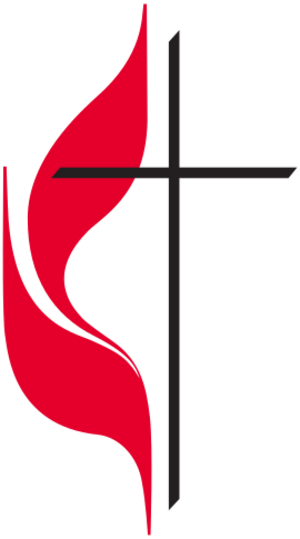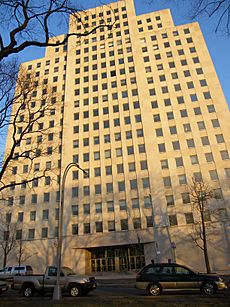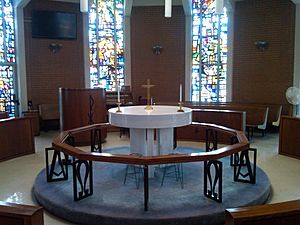United Methodist Church facts for kids
Quick facts for kids United Methodist Church |
|
|---|---|

The United Methodist Church "cross and flame" emblem
|
|
| Abbreviation | UMC |
| Classification | Protestant |
| Orientation | Methodist and United Brethren |
| Theology | Wesleyan |
| Polity | Connexionalism |
| President | Tracy Smith Malone |
| Secretary | L. J. Holston |
| Annual conferences | 132 |
| Episcopal areas | 66 |
| Associations | World Council of Churches Churches Uniting in Christ Christian Churches Together National Council of Churches Wesleyan Holiness Consortium Christian Holiness Partnership World Methodist Council |
| Founder | John Wesley (spiritually) |
| Origin | 1968 |
| Merger of | The Methodist Church and the Evangelical United Brethren Church |
| Separations | New Methodist Conference (2005) Ang Iglesia Metodista sa Pilipinas (2011) Global Methodist Church (2022) |
| Congregations | 39,460 (29,746 in the US) |
| Members | 9,984,925 (5,424,175 in the US) |
| Ministers | 83,800 |
| Aid organization | United Methodist Committee on Relief |
| Secondary schools | 10 |
| Tertiary institutions | 109 |
The United Methodist Church (UMC) is a large Protestant Christian group. It is based in the United States but has members all over the world. The UMC is a major part of Methodism. Its roots go back to a Christian movement started by John Wesley and Charles Wesley in England. It also connects to a movement called the First Great Awakening in the United States.
The UMC was formed in 1968 in Dallas, Texas. This happened when two churches, the Methodist Church and the Evangelical United Brethren Church, joined together. The UMC believes in Wesleyan teachings. It uses traditional worship styles, focuses on holy living, and shares its faith with others.
The United Methodist Church has a "connectional" system. This means its churches and leaders are linked together. It is organized into groups called conferences. The highest group is the General Conference. This group is the only one that can speak officially for the UMC. The church is part of the World Council of Churches and the World Methodist Council.
In 2022, the UMC had over 5.4 million members and nearly 30,000 churches in the United States. Worldwide, it had almost 10 million members and over 39,000 churches. A 2015 study showed that even more adults in the US identified with the UMC than were officially registered members.
In recent years, some churches have left the UMC. This was due to disagreements over church rules. In 2020, some leaders suggested a plan for a split. This led to the creation of the Global Methodist Church in 2022. By the end of 2023, about one-quarter of UMC churches in the US had left. In May 2024, the United Methodist Church General Conference changed some of its rules.
The UMC Story
How the Church Began
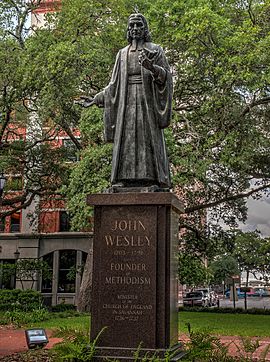
The United Methodist Church started in the mid-1700s. It began as a movement within the Church of England. A small group of students at Oxford University met regularly. This group included John Wesley, Charles Wesley, and George Whitefield. They focused on studying the Bible and living a very religious life. Other students made fun of them. They called them the "Holy Club" and "the Methodists." This was because of their careful and detailed way of studying and living.
Later, these "Methodists" started small groups. These groups were for members of the Church of England. They wanted to live a more religious life.
In 1735, John and Charles Wesley traveled to America. John became a church leader in Savannah. His preaching was very strict, and people did not like it. After two years, he returned to England feeling sad. On his trip to America, he had been impressed by the faith of German Moravians. When he returned, he talked with a Moravian named Peter Böhler. Böhler believed people are saved by God's grace, not by good deeds.
On May 25, 1738, John Wesley realized something important. He understood that his good actions could not save him. He found peace and felt sure of God's salvation.
The "Holy Club" eventually broke up. John Wesley met with other church leaders. He said they wanted to be "Bible-Christians" and preach "plain, old, Bible Christianity." These ministers stayed part of the Church of England. They taught that salvation comes from God's grace through faith in Christ. They believed in three main things:
- Everyone is born with sin and needs God's help.
- People are made right with God only by faith.
- This faith leads to holiness in how people live.
These ministers became very popular. They attracted many followers. The nickname "Methodists" was used again for them and their followers.
Early Methodist Churches
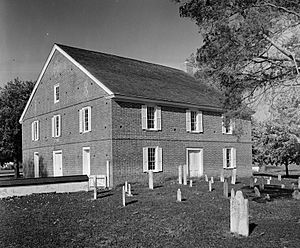
An English preacher named Francis Asbury came to America in 1771. He became a "circuit rider." This meant he traveled far and wide to share the Christian message. The first official Methodist group in the United States started in Baltimore, Maryland, in 1784. This was at the Christmas Conference. Francis Asbury and Thomas Coke were the leaders. They formed the Methodist Episcopal Church.
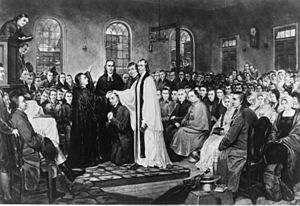
John Wesley wanted Methodists to stay within the Church of England. But the American Revolution separated American Methodists from the English Church. In 1784, Wesley appointed Thomas Coke as a "Superintendent" (like a bishop). Coke was to organize a separate Methodist group in America. Wesley also sent a worship book and rules for the new church. These were accepted at the Baltimore Christmas Conference in 1784. This officially created the Methodist Episcopal Church. The conference was held at the Lovely Lane Methodist Church. This church is seen as the "mother church" of American Methodism.
The new church grew quickly in the young United States. It used circuit riders. These were often regular people, not just church leaders. They rode horses across the country. They preached and started churches. Soon, almost every town had a Methodist presence. By 1844, there were 4,000 circuit riders. The Methodist Episcopal Church became the largest Protestant church in the country.
St. George's United Methodist Church in Philadelphia is the oldest Methodist church still in use in the United States. It started in 1769. The church was saved from being torn down in the 1920s. This was to make way for the Benjamin Franklin Bridge. The court case moved the bridge instead. Today, Historic Saint George's welcomes visitors. It has a museum about Methodism.

Richard Allen and Absalom Jones were the first African Americans to become Methodist church leaders. They were given permission by Saint George's Church in 1784. Three years later, they protested against racial segregation in church. Allen led most Black members out of St. George's. They later founded the Mother Bethel A.M.E. Church and the African Methodist Episcopal Church.
Over 220 years, Methodism in the US has had many splits and mergers. In 1830, the Methodist Protestant Church separated from the Methodist Episcopal Church. This was because they wanted regular church members to have a say in how the church was run. In 1844, the Methodist Episcopal Church split into two groups. This was due to disagreements over slavery and the power of bishops.
The two groups, the Methodist Episcopal Church (North) and the Methodist Episcopal Church, South, stayed separate until 1939. That year, they merged with the Methodist Protestant Church. They formed The Methodist Church.
The 1968 Merger
On April 23, 1968, the United Methodist Church was created. This happened when the Evangelical United Brethren Church and The Methodist Church joined together. The meeting took place in Dallas, Texas. The new church was born with the words, "Lord of the Church, we are united in Thee, in Thy Church and now in The United Methodist Church." Both churches had long histories and important work around the world.
Recent Changes (2020–2024)
Before May 2024, the UMC had rules in its Book of Discipline. These rules did not allow certain unions or the ordination of some people. Many UMC leaders and churches, especially in the United States, wanted to change these rules. Many members who held more traditional views did not like this trend. This led to movements to split from the UMC.
In January 2020, church leaders suggested a plan to divide the church. This was because of "fundamental differences" over certain church teachings. This plan needed to be approved by the General Conference. The 2020 General Conference was delayed because of the COVID-19 pandemic.
In November 2020, a small group of more progressive members announced they wanted to create a new church. This was called the Liberation Methodist Connexion. However, this separate church did not fully form.
In March 2021, traditional leaders announced the name Global Methodist Church for their new group. The next General Conference was set for 2024. At this meeting, delegates were expected to vote on a plan for reconciliation and separation. Some traditional UMC churches did not want to wait. They left the UMC to join the Free Methodist Church. After the Global Methodist Church started on May 1, 2022, many traditional UMC churches joined it. Other former UMC churches joined different Methodist groups.
In May 2022, the UMC's Judicial Council ruled that only individual churches could leave the UMC for the Global Methodist Church. Whole conferences could not. Some conferences, like Romania-Bulgaria, did leave.
By early 2022, the UMC had approved 300 requests for individual churches to leave. Many more churches were thinking about leaving. Some of the largest churches in several US states planned to leave. Churches that left had to pay two years of their church contributions and pension costs. Some UMC conferences named certain churches "lighthouse congregations." These churches offered support to members who wanted to stay with the UMC.
By December 30, 2023, 7,660 UMC churches in the United States had been approved to leave. This was about one-quarter of all UMC churches in the US.
The 2024 General Conference met from April 23 to May 3 in Charlotte, North Carolina. Many of the more traditional churches had already left. The conference approved several changes. These included allowing different regions outside the US to have their own rules. They also removed language that said certain practices were "incompatible with Christian teaching." They ended bans on same-sex weddings and gay clergy.
What United Methodists Believe
The United Methodist Church wants to help people become followers of Christ. They do this by reaching out to others and by seeking holiness. This means growing closer to God through the Holy Spirit. The flame in the church logo shows the Holy Spirit's work. The two parts of the flame also stand for the two churches that merged in 1968.
The United Methodist Church sees itself as part of the larger Christian Church. It uses old Christian statements of faith, like the Apostles' Creed and the Nicene Creed. These are often used in worship services. The church also believes in the "visible and invisible Church." This means all true believers belong to the invisible Church. The United Methodist Church is a part of the visible Church.
Some people believe the United Methodist Church has a connection to the early church leaders. This is called apostolic succession. John Wesley, the founder, appointed leaders when American Methodists separated from the Church of England. He believed that bishops and priests were part of the same order. He knew that some early churches kept their line of bishops through priests alone. Methodists who believe in apostolic succession do so based on these ideas.
Many United Methodist churches follow an evangelical style. Others are more like mainline Protestant churches. United Methodist beliefs come from the writings of its founders. These include John Wesley and Charles Wesley. They also include Philip William Otterbein, Martin Boehm, and Jacob Albright. When the UMC formed in 1968, a theologian named Albert C. Outler helped organize its beliefs.
Main Teachings
The official teachings of United Methodism are:
- The Articles of Religion of the Methodist Church.
- The Confessions of Faith of the Evangelical United Brethren Church.
- The General Rules of the Methodist Societies.
- The main sermons of John Wesley.
- John Wesley's Explanatory Notes on the New Testament.
These teachings are very important and are hard to change. Other UMC beliefs are found in the Book of Discipline of the United Methodist Church.
Basic Beliefs Summary
Here are some basic beliefs of the United Methodist Church:
- God is Three-in-One: God is one God in three persons: Father, Son, and Holy Spirit. This is called the Triune God.
- The Bible: The Bible is God's inspired word. United Methodists believe the Holy Spirit helps them understand the Bible today. They balance the original meaning with how it applies to life now.
- Sin: Humans were made in God's image. But all humans are sinners, and this image is damaged. Sin separates people from God. Humans cannot save themselves.
- Salvation through Jesus Christ: God's love saves sinners through Jesus. This includes Jesus' life, teachings, death on the cross, resurrection, and his presence today.
- Sanctification: This is God's grace helping people grow in Christian perfection. Wesley described this as having a heart full of love for God and others. It means living like Christ.
- Sacraments: United Methodists recognize two sacraments: Holy Baptism and Holy Communion. Other important ceremonies include Confirmation, Ordination, weddings, funerals, and Anointing of the Sick.
- Baptism: Baptism is a sign of new life in Christ. It is a way God makes a promise with people. It brings people into the Church. Baptism is not repeated. It is a way to receive God's grace. The UMC usually baptizes by sprinkling, pouring, or immersing. It uses the Trinitarian formula (in the name of the Father, Son, and Holy Spirit). The UMC also baptizes babies. When baptized infants grow up, they can confirm their baptismal promises through Confirmation.
- Holy Communion: The UMC believes Christ is truly present in Holy Communion. They do not believe the bread and wine literally become Christ's body and blood. They believe the bread and cup are signs of Jesus' body and blood given for humanity. Through these signs, Christ's body and blood are offered to believers. The UMC celebrates Communion to remember Jesus' death. It is a way to receive God's grace. All are welcome to take communion.
- Free Will: The UMC believes that people, even with sin, can make their own choices. This is because God's grace helps them. People are responsible to God for their choices.
- Social Justice: The Church stands against things like slavery, unfair prison conditions, capital punishment, economic unfairness, child labor, and racism. It works for equality.
Wesleyan Focuses
Wesley's theology highlights how God's grace works in people. He described grace in three parts: Prevenient Grace, Justifying Grace, and Sanctifying Grace.
Prevenient grace is given to everyone. It is the power that helps us love and seek God through Jesus. This grace helps us see our sin and God's offer of salvation. It allows people, even with sin, to freely choose to accept or reject God's salvation.
Justifying Grace is the grace God offers to all. We receive it by faith in Christ. Through this grace, God forgives our sins. We are accepted by God despite our sins. This grace removes our guilt and helps us resist sin. It helps us love God and others fully. Today, this is also called conversion or being "born again." John Wesley called it the New Birth. This can be a single moment or a series of choices over time.
Sanctifying Grace is God's grace that helps believers grow toward Christian Perfection. This means truly loving God with all your heart and loving your neighbors as yourself. This grace helps us live a life filled with the Holy Spirit and like Christ. Wesley believed all Christians could reach this state of perfection. He disagreed with others who thought people could never stop sinning in this life.
Wesleyan theology teaches that salvation is completely God's grace. It covers everything from the invitation to forgiveness to growing in holiness. God's grace works in Christians throughout their lives.
Good actions are seen as the result of salvation, not how it is earned. Faith and good works go together in Methodist belief. A healthy tree naturally produces fruit. Wesleyan theology does not believe that salvation can never be lost. It teaches that salvation can be rejected. Wesley stressed that believers must keep growing in their relationship with Christ through sanctification.
This theology leads the United Methodist Church to focus on two things. First, sharing the message of repentance and a personal relationship with God. Second, working for social justice. This has included fighting against slavery, for women's rights, for workers' rights, and for civil rights. It also includes helping the poor.
Understanding Wesleyan Theology
Methodist theology combines different Christian ideas. It is both evangelical and focused on holiness. It uses both traditional worship and more lively, charismatic styles. It is also a mix of Anglo-Catholic and Reformed worship. It is known as Wesleyan–Arminian theology. It emphasizes the Holy Spirit's work to bring holiness into a believer's life. The United Methodist Church believes in prima scriptura. This means the Bible is the main authority. It uses Christian tradition, reason, and experience to understand the Bible. This is called the Wesleyan Quadrilateral. So, United Methodist theology is "catholic, evangelical, and reformed."
Today, the UMC is generally seen as a moderate and tolerant church. This is true for issues like race, gender, and ideas. However, the church has many different viewpoints within it. The UMC is more traditional than some liberal Protestant groups. But it is more open on social justice and Bible interpretation than some very traditional evangelical groups. Because of this, there are many different beliefs among UMC leaders and members.
Different Views Within the Church
John Wesley encouraged tolerance for different theological ideas. He said, "Though we may not think alike, may we not all love alike?" A common saying among Methodists is: "In essentials, unity; in non-essentials, liberty; in all things, charity." Methodists have always had many different opinions on various church matters.
The United Methodist Church allows for a wide range of beliefs. For example, former US President George W. Bush and former First Lady Laura Bush are United Methodists. So are Senator Elizabeth Warren and former Secretary of State Hillary Clinton.
A 2014 study found that 54% of US adult UMC members leaned Republican. 35% leaned Democrat. 11% were independent or other.
Social Topics
Beliefs on Creation
The United Methodist Church believes that faith and the theory of evolution do not conflict. Like many other Protestant churches, the UMC officially supports the theory of evolution. It "opposes introducing theories such as Creationism or Intelligent Design into public school curriculum." In 2016, the church did not allow a creationist group to be officially represented at its General Conference.
Gun Safety
The United Methodist Church supports government efforts for strict gun control in the United States. It supports bans on most weapons in other countries. The Church also states that all its churches are "weapon-free zones."
Military Service
The UMC asks those who serve in the military to think about their actions. They should consider church teachings on when war is right. This includes questions about fairness and protecting people who are not fighting.
The United Methodist Church is against conscription (forced military service). It supports people who do not believe in war. It also supports those who choose to serve in the armed forces. The church says that neither military action nor inaction is always right before God.
The UMC believes that war does not fit with Christ's message. It rejects war as a tool for national policy. War should only be used as a last choice to stop great evils. These evils include genocide or severe human rights abuses. The church says nations must first try to solve problems peacefully. Human values should be more important than military needs. The church wants to reduce and control weapons. It condemns nuclear weapons. Therefore, the UMC supports complete disarmament under international control.
The United Methodist Church provides military chaplains. These are church leaders who serve in all parts of the US Armed Forces.
Worship and Church Services
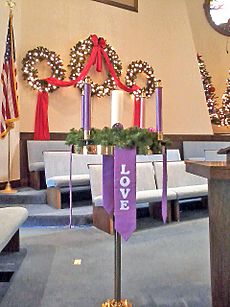
The United Methodist Church has different ways of worshiping. The common way of worship comes from the church's official services. However, practices vary among churches.
John Wesley believed the Church of England's prayer book was very good. When American Methodists separated, John Wesley created his own version. This book, The Sunday Service of the Methodists; With Other Occasional Services, has shaped Methodist worship ever since.
Like other Christian churches, the UMC has official services for Holy Communion, baptism, weddings, funerals, ordination, and anointing the sick. Some church leaders offer healing services. In Africa, some leaders may perform exorcisms. These services often involve laying on of hands and anointing with oil. There are also special services for holy days. These include All Saints Day, Ash Wednesday, Maundy Thursday, Good Friday, and Easter Vigil. These services are in The United Methodist Hymnal and The United Methodist Book of Worship (1992). Many of these services come from the Anglican tradition. Most churches also use candles, church clothes, banners, and art in their worship.
Typical United Methodist worship services include:
- Singing: Singing has always been important in Methodist worship. The church publishes an official hymnal, The United Methodist Hymnal. Churches use hymns and modern worship music.
- A Bible Message: Reading from the Bible and a sermon based on it are almost always part of worship. Many UMC churches follow a reading plan called the Revised Common Lectionary.
- Prayer: Many churches include a time for prayer. People can share concerns or pray with ministers. This time might also include celebrating baptism, confirmation, or making a statement of faith.
- Holy Communion: Some churches celebrate communion once a month. Others do it every three months. More churches are celebrating communion weekly, as John Wesley encouraged. The church encourages using official services for communion.
- Lovefeast: Many churches celebrate the Lovefeast (also known as the Agape Feast) every three months. This involves sharing bread and water. People also share their faith stories, read Scripture, and sing hymns.
- Giving: Almost every service includes a chance to give "tithes and offerings." This supports the local church's work. Part of these gifts also goes to national and global Christian ministries.
Many larger UMC churches use modern music and technology in some services. However, they usually still offer more traditional services too.
John Wesley encouraged preaching outdoors. So, revival services are a traditional Methodist practice. These are often held in churches, at outdoor camp meetings, and at tent revivals.
The front area of a United Methodist church, called the chancel, usually has a lectern (for reading) and a baptismal font on one side of the altar table. A pulpit (for preaching) is on the other side. The chancel also has the Christian Flag and sometimes a cross. It is often separated by rails. Sometimes there is a mourner's bench in front.
Order of Worship
A typical United Methodist service might include:
Gathering
- Prelude (music before the service)
- Chiming of the Hour
- The Procession (people walking in)
- Lighting of the Candles
- Voluntary (music)
- Introit (choir singing)
- Call to Worship
- Opening Prayer
- Invocation (a prayer asking for God's presence)
- Announcements
- Welcoming/Greeting
- Passing the Peace (greeting others)
- Hymn of Praise
- Act of Praise
- Responsive Reading (reading together)
- Gloria Patri (a short song of praise)
Prayers
- Joys and Concerns (sharing prayer requests)
- Prayer of Confession (confessing sins)
- Absolution (declaration of forgiveness)
- The Lord's Prayer
- Pastoral Prayer (prayer by the pastor)
- Collect (a short prayer)
- Prayer of Intercession (praying for others)
- Bidding Prayer (praying for specific needs)
- Prayer of the People
Proclamation
- Choral Anthem (choir singing)
- Choral Worship
- Drama Presentation
- The Lessons (readings from the Old Testament, Psalms, Epistles, and Gospels)
- Prayer of Illumination (prayer for understanding the Bible)
- Hymn of Preparation
- Time of Personal Witness / Testimony (sharing faith stories)
- Children's Sermon / Moments
- Introduction of the Preacher
- Sermon (the main message)
Going Forth
- Benediction (a blessing)
- Closing Prayer
- Extinguishing of the Candles
- Choral Response (choir singing)
- The Recessional (people walking out)
- Postlude (music after the service)
Saints in the UMC
The United Methodist Church's idea of a "saint" is different from some other churches. Methodists do not have a process to declare people saints. They do not pray to saints or believe saints act as go-betweens to God. The UMC believes all faithful Christians are saints.
Methodist churches might be named after a Bible figure (like "St. James UMC"). Methodists also honor important Christian heroes. These "saints" show examples of holy living and commitment to Christ. They include martyrs (who died for their faith), confessors of the Faith, evangelists, or important biblical figures. People like Dietrich Bonhoeffer (a Lutheran theologian), William Booth (founder of The Salvation Army), David Livingstone (a missionary), and John Wesley (Methodism's founder) are seen as Protestant saints.
Article XIV of The United Methodist Articles of Religion clearly says no to "invocation of saints" (praying to saints). It states that praying to saints is not based on the Bible.
How the Church is Organized
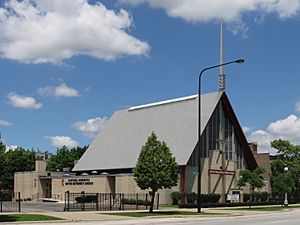
Church Leadership
The church is organized with the General Conference as its main governing body. The church's structure is similar to the United States government:
- General Conference: This is like the legislative branch. It makes all decisions about beliefs and rules.
- Council of Bishops: This group, along with other church agencies, acts like an executive branch. It includes all active and retired bishops. They meet twice a year. The Council of Bishops speaks to the church and the world. They lead efforts for Christian unity.
- Judicial Council: This is like the judicial branch. It has nine people chosen by the General Conference. They decide if church laws and practices follow the church's constitution.
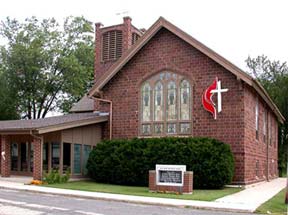
General Conference Meetings
The United Methodist Church is organized into conferences. The highest level is the General Conference. It is the only group that can officially speak for the church. The General Conference meets every four years. Changes to church laws are written in The Book of Discipline. Other decisions are in the Book of Resolutions. Bishops and other leaders cannot speak for the whole UMC. Only the General Conference has this power.
An active bishop leads the main meetings. They are usually joined by experts on rules.
The church had planned to hold a conference outside the United States for the first time in 2024. But these plans were canceled. Organizers could not find a large enough space for the two-week meeting.
Regional and Central Conferences
Below the General Conference are the jurisdictional and central conferences. These also meet every four years. The United States has five regions. Outside the US, the church has seven central conferences. The main job of these conferences is to choose and appoint bishops. Bishops are the church's chief leaders. Central conferences can also make small changes to church law for their areas. Bishops lead episcopal areas, which include one or more annual conferences.
In the US, decisions between the four-year meetings are made by the Mission Council. This council usually includes church bishops.
Judicial Council Decisions
The Judicial Council is the highest court in the UMC. It has nine members. They are chosen by the General Conference for eight-year terms. Both regular members and church leaders are part of it. The Judicial Council explains the Book of Discipline between General Conference meetings. During the General Conference, it decides if new laws are constitutional. The Council also checks if actions by local churches, conferences, and bishops follow church law. It reviews all legal decisions made by bishops. The Judicial Council cannot create laws. It can only explain existing ones. The Council meets twice a year. It also hears appeals from those accused of serious offenses.
Annual Conferences
The annual conference is the basic unit of the UMC. It is like a diocese in other churches. The term "annual conference" refers to both the area it covers and how often it meets. Clergy (church leaders) are members of their annual conference. They are appointed to a local church each year by the conference's bishop. The United Methodist Church works as a network of annual conferences. Actions by one conference do not bind another.
Districts
Annual conferences are divided into districts. Each district has a district superintendent. These superintendents are chosen each year by the bishop from the ordained elders. After serving as superintendent, they usually return to leading local churches. The bishop and district superintendents form the annual conference cabinet.
Local Churches
The Book of Discipline guides local churches and pastors. It details how local United Methodist churches are organized. All UMC churches must have a board of trustees (3 to 9 members). No gender should make up more than two-thirds of the board. Churches must also have a nominations committee, a finance committee, and a church council. Other committees are suggested but not required. Term limits apply to some committees. The church conference is a yearly meeting of all church officers and interested members. This group sets pastors' salaries and chooses committee officers.
Church Offices
There is no single official headquarters for the UMC. Many of its largest offices are in Nashville, Tennessee.
While the General Conference is the only group that can officially speak for the UMC, there are 13 main agencies, boards, and commissions. These groups handle specific topics for the whole church. Their offices are across the United States.
- Discipleship Ministries (Nashville, Tennessee)
- Wespath Benefits and Investments (Glenview, Illinois)
- General Board of Church and Society (Washington, D.C.)
- General Board of Global Ministries (Atlanta, Georgia)
- United Methodist Committee on Relief (Atlanta, GA)
- General Board of Higher Education and Ministry (Nashville, TN)
- General Commission on Archives and History (Madison, New Jersey)
- General Commission on Religion and Race (Washington, DC)
- General Commission on the Status and Role of Women (Chicago)
- General Commission on United Methodist Men (Nashville, Tennessee)
- General Council on Finance and Administration (Nashville, Tennessee)
- United Methodist Communications (Nashville, Tennessee)
- United Methodist Publishing House (Nashville, Tennessee)
- United Methodist Women (New York City, New York)
UM Volunteers in Mission
United Methodist Volunteers in Mission (UMVIM) is the short-term mission part of the United Methodist Church. UMVIM helps organize mission projects for over 100,000 volunteers each year. It also coordinates over 400 international development projects.
Education and Learning

The United Methodist Church has always valued education. It has started and is connected to about one hundred colleges and universities in the United States. These include American University, Syracuse University, Boston University, Emory University, Duke University, and Southern Methodist University. Most are part of the International Association of Methodist-related Schools, Colleges, and Universities. The church also runs 360 schools and institutions overseas.
There are 13 United Methodist seminaries (schools for training church leaders). United Methodist members are often highly educated. Many have graduate or post-graduate degrees. The church also has a higher number of high-income earners.
Church Leaders (Clergy)
United Methodist clergy include elders, local pastors, associate members, and deacons. They are members of the annual conference, not just a local church. Provisional clergy are also members of the annual conference. There are several types of ministry roles in the UMC.
Certified lay ministers can also lead a church. They do so under the guidance of an elder.
History of Clergy Roles
The first Methodist clergy were appointed by John Wesley. This happened because the American Revolution cut off American Methodists from the Church of England. Today, clergy include men and women. They are ordained by bishops as elders and deacons. They are appointed to various ministries. Elders in the UMC move to different churches as appointed by their bishops. They usually serve as pastors in local churches. Deacons serve in "service" ministries. They might be musicians, educators, or business administrators. Elders and deacons must earn a master's degree (like an M.Div.) before being ordained.
Women as Clergy
The Methodist Church has allowed ordination of women since 1956. This means women can be full church leaders. This decision was based on their understanding of the Bible. The United Methodist Church believes that when you understand the historical context, the Bible supports women's ordination.
Bishops
All clergy appointments are made each year by the resident bishop. They get advice from the Annual Conference Cabinet. This cabinet includes the bishop and the district superintendents. An appointment is not official until the bishop announces it. While appointments are made yearly, leaders usually stay in a role for several years. Appointments for special ministries, like military chaplaincy, can be even longer.
Elders
Elders are called by God and affirmed by the church. They are ordained by a bishop. They lead in preaching, sacraments, and guiding the church. They can serve in local churches or other ministries. Elders have the power to preach, give sacraments, offer care, and organize the church's work. Elders can also become district superintendents or be chosen as bishops. Elders serve two to three years as provisional elders before being fully ordained.
Deacons
Deacons are called by God and affirmed by the church. They are ordained by a bishop to serve and lead. They focus on ministries of service, compassion, and justice. They can serve in local churches or other ministries that support the church's mission. Deacons lead, preach, help in worship, perform marriages, and assist in baptisms and Holy Communion. They can be given power to perform sacraments if their role requires it and the bishop approves. Deacons serve two to three years as provisional deacons before being fully ordained.
Provisional Clergy
In 1996, new roles were created: "provisional elder" and "provisional deacon." These are for those seeking to be ordained. A provisional elder/deacon is a seminary graduate. They serve at least two years in full-time roles after being appointed. During this time, they may be allowed to perform sacraments in their local church. This made it normal for non-ordained pastors to serve.
Local Pastors
Local pastors are called by God and affirmed by the church. They are appointed by a bishop to lead in preaching, sacraments, and service. They have the power to preach, give sacraments, offer care, and organize the church. However, they are not ordained. When an ordained elder is not available, a bishop may appoint a "local pastor." Local pastors often have other jobs. Full-time and part-time licensed local pastors are clergy members of the annual conference. They preach, lead worship, and perform regular pastor duties. A local pastor's power is only for their specific appointment. Local pastors do not need advanced degrees. But they must attend licensing school and continue their education. When they retire or are no longer appointed, they return to being regular church members.
Church Members (Laity)
There are two types of lay members in the UMC: Baptized Members and Professing Members.
The United Methodist Church baptizes both infants and adults. Baptized Members are those baptized as a baby or child. They have not yet stated their own faith. These Baptized Members become Professing Members through confirmation or by stating their faith. People who were not baptized before are baptized when they state their faith. They then become Professing Members. People can also become a Professing Member by transferring from another Christian church.
Baptism is a sacrament in the UMC. The Book of Discipline of the United Methodist Church says local churches should offer classes for all people to prepare for membership or confirmation. "Confirmation" is usually for youth. "Membership class" is for adults. In these classes, students learn about the Church and Methodist beliefs. This helps them state their faith in Christ.
Regular church members (laity) are very important in the UMC. Professing Members are part of all major church decisions. General, Jurisdictional, Central, and Annual Conferences must have an equal number of regular members and clergy.
In a local church, many decisions are made by an administrative board or council. This council is made up of regular members from different church groups. The elder or local pastor is also a voting member of this council.
Regular members can also serve the church in special roles:
Lay Servant
A lay servant is another role in the UMC. They are not clergy. But lay servants often preach when an ordained leader is not available. There are two types: local church lay servant and certified lay servant. Local church lay servants serve in their own churches. Certified lay servants serve in their own churches, other churches, and district or conference projects. To be a local church lay servant, you need a recommendation and to complete a basic course. You must reapply each year. To be a certified lay servant, you need a recommendation, the basic course, and one advanced course. You also have an interview. You must reapply yearly and take an advanced course every three years.
Certified Lay Ministers
The 2004 General Conference created a new role: the certified lay minister (CLM). CLMs are not clergy. They remain regular members of the UMC. A Certified Lay Minister is a qualified United Methodist member. They are called to lead in a church as part of a team, under an ordained minister.
To become a CLM, a person goes through a certification process. This includes training, support, and accountability. CLMs are regular members serving their call as followers of Jesus Christ.
Working with Other Churches
Methodism is one part of the Christian Church. The United Methodist Church actively works with other Christian groups. It is a member of the National Council of Churches, the World Council of Churches, and Christian Churches Together. It also sought to be an observer in the National Association of Evangelicals. However, some in the UMC worry that too much unity might blur important differences in beliefs.
In 2005, the UMC approved a step towards sharing communion with the Evangelical Lutheran Church in America (ELCA). The ELCA also approved this. In 2008, the UMC approved full communion with the ELCA. This means they recognize each other's churches and share sacraments.
Since 1985, the United Methodist Church has explored merging with three historically African-American Methodist churches. These are the African Methodist Episcopal Church, the African Methodist Episcopal Zion Church, and the Christian Methodist Episcopal Church. A special group was formed in 2000 to work on this. In May 2012, the UMC entered into full communion with these churches. They agreed to recognize each other's churches, share sacraments, and affirm each other's leaders.
There are also churches like the Evangelical Methodist Church in Argentina and Methodist Church in India that are "autonomous affiliated" churches with the UMC.
The UMC is a member of the Wesleyan Holiness Consortium. This group works to promote Biblical holiness today. Many UMC churches are also part of the Christian Holiness Partnership. The UMC is active in the World Methodist Council. This group brings together different churches in the tradition of John Wesley. Its goal is to share the Gospel worldwide. In 2006, the World Methodist Council agreed to adopt the "Joint Declaration on the Doctrine of Justification." This was already approved by the Vatican and the Lutheran World Federation.
Membership Changes
Like many other mainline Protestant churches in the United States, the United Methodist Church has seen fewer members in recent years. When it formed, the UMC had about 11 million members. By 1975, membership dropped below 10 million. In 2005, there were about 8 million members. Most members are in the Midwest and South of the US. Texas has the most members, with about 1 million. States with high membership rates include Oklahoma, Iowa, Mississippi, West Virginia, and North Carolina.
By 2008, total UMC membership was about 11.4 million. About 7.9 million were in the US and 3.5 million overseas. About 20% of the conference delegates were from Africa. Filipinos and Europeans made up another 10%. During the conference, the Methodist Church of the Ivory Coast and its 700,000 members officially joined. With US churches losing members and overseas churches growing, especially in Africa, it was thought that Africans would make up a large part of future conferences. One bishop from the Democratic Republic of the Congo estimated that Sunday attendance in his country was higher than in the entire United States.
In 2018, outside the United States, the UMC had over 6.4 million members and almost 13,000 churches.
In 2020, it had over 6.2 million members and over 30,000 churches in the United States.
Church Giving
Money given to the local church helps not only that church. It also helps regional, national, and international ministries. This is through the United Methodist Church's system of "connectional giving." This combined giving helps educate clergy, work with other churches, fund the General Conference, support historically black colleges, and support bishops.
People can also give to the church by naming the Permanent Fund for the United Methodist Church in their estate plans. This fund provides lasting money for the UMC's ministries.
|
See also
 In Spanish: Iglesia metodista unida para niños
In Spanish: Iglesia metodista unida para niños
- List of the largest Protestant bodies
- Conferences of the United Methodist Church
- Confessing Movement
- Holiness Movement
- Reconciling Ministries Network
- List of local Methodist churches
- Christianity in the United States


